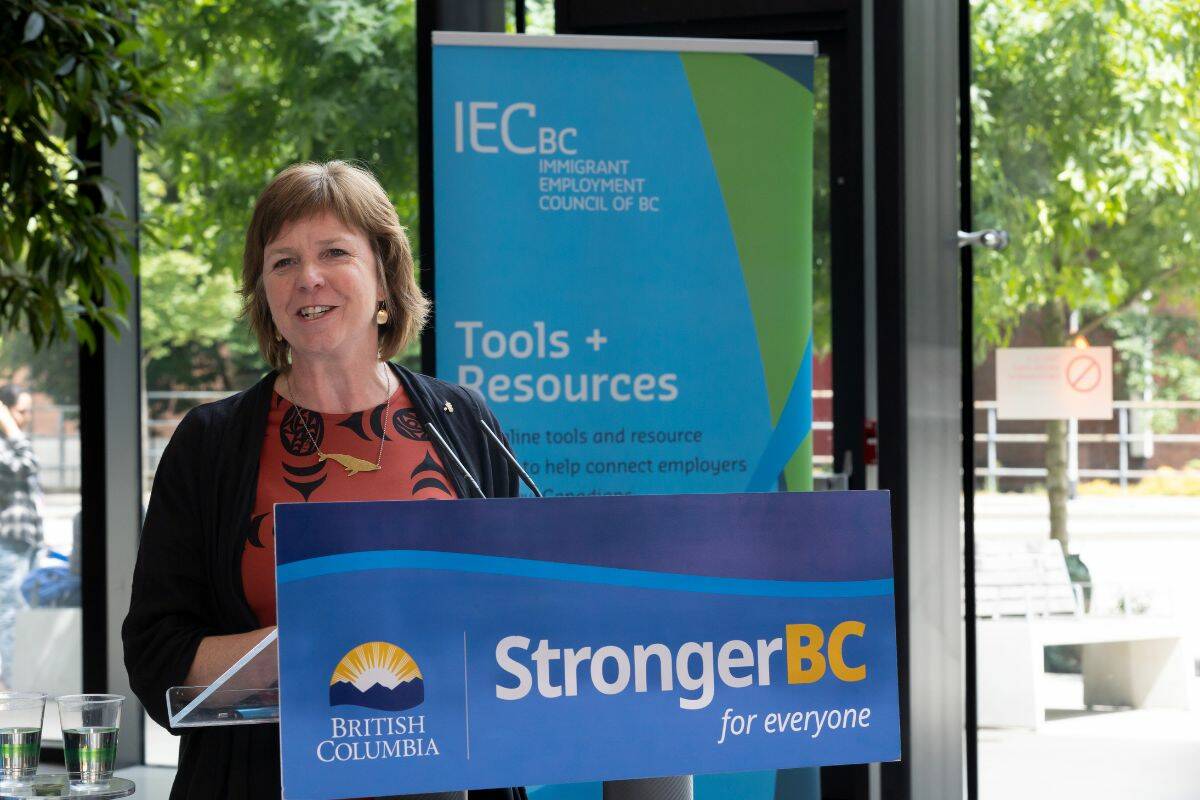B.C. Social Development Minister Sheila Malcolmson Tuesday defended the ambition of her government’s new anti-poverty goals as “both ambitious and realistic” and promised to present more concrete proposals next month.
Legislation tabled Tuesday would see B.C. cut overall poverty rates by 60 per cent, child poverty by 75 per cent and seniors’ poverty by 50 per cent within the next decade, the last goal being a first for B.C. Existing targets commit government to reduce overall poverty by 25 per cent and child poverty by 50 by 2024.
While Malcolmson said B.C. has already exceeded its goal to reduce overall poverty by 20 per cent, global inflation and rising costs of living have been especially hard on people who are already struggling.
“So we are setting new ambitious poverty reduction targets,” she said. She later acknowledged that COVID-19 relief helped play a role in reducing provincial poverty rates, but said that government was already exceeding its goals in 2019.
Malcolmson presented the new targets against the backdrop of rising homelessness and other measures of growing poverty. They include a new report from First Call Child and Youth Advocacy Society that found child poverty rates are rising in B.C. with 126,000 children meeting the definition.
RELATED: B.C. child poverty rate increases for first time in a decade: advocacy group
RELATED: Pandemic benefits pushed down B.C.’s child poverty rate in 2020: advocacy group
When Malcolmson was asked why her government would not aim to cut various poverty rates by 100 per cent, she said that would be ideal.
“We don’t want to have a single child in poverty, we don’t want a single senior in poverty,” she said. “At the same time, we chose targets that were achievable in the time line. If we exceed them, so much the better. ” Malcolmson added the federal government controls most of the levers for senior assistance.
“(We) do have a provincial senior supplement, which we have doubled, and we certainly have lots of programs that are targeted toward seniors, but it is more of a federal (field),” she said.
Government will follow these new goals with a concrete plan when it presents its new poverty reduction strategy, she added.
BC Green Leader Sonia Furstenau said her party will scrutinize the new legislation, while raising concerns.
“Simply put, poverty reduction is not good enough,” Furstenau said. “We need a poverty elimination strategy. (Otherwise), we can’t take this government seriously,” she said.
“The provincial government is not setting targets to create a greater quality of life for people, they’re simply setting these targets to manage the truly unaffordable cost of living,” Adam Olsen, BC Green House Leader, added.
While last month’s provincial budget includes several temporary relief measures, experts pointed out that it neither raised the income assistance rate ($1,060 per month for an individual) nor the disability rate ($983.50 per month for an individual).
About 230,000 British Columbians receive income assistance, disability assistance and other supports.
“We are always trying to move the dial,” Malcolmson said, adding her government has raised these rates five times since coming into government in 2017. “Surely, more will come again.”
She also pointed out that last’s year lift to the shelter allowance to $500 per month from $375 per month was the first since 2007.
“So we are certainly catching up, making up for a long time of under-investment in the sector,” she said. “We are doing it step-by-step, whether it is in health care, housing, raising (various assistance) rates.”
Rowan Burge, provincial director of the BC Poverty Reduction Coalition, last month welcomed the temporary relief measures, but lamented the lack of more substantial reforms.
“(One-time benefits) aren’t the substantial structural changes that we need to see to see poverty being reduced or eradicated in B.C. I absolutely would have loved to have seen a raise in the (income and social assistance) rates, because right now, they are still well below the poverty line.”
Burge also added she would have loved to have seen a progressive wealth tax, which several economists have said would help B.C. generate the revenue for investments in physical and social infrastructure.
RELATED: B.C. Budget 2024: opposition parties slam NDP’s 2024 provincial budget
RELATED: BUDGET 2024: B.C. runs record deficit of almost $8B, focuses on temporary relief
When asked about the absence of such a tax, Malcolmson said her government raised taxes on B.C.’s wealthiest two per cent, while cutting taxes for everybody else.
“Since then, we have been continuously investing in the people, with my own ministry having raised (income and disability assitance) rates five times (for a total increase of $450 each for a single person) and having made earning exemptions more generous, so people can (keep) more earned income. That work will continue and we will continue to invest in people who need the help the most.”
According to Malcolmson, anti-poverty measures so far, have helped more than 250,000 people out of poverty. But the most recent data stems from 2021-2022.
Malcolmson acknowledged this gap, but new federal data might become available within a month.
“But we know anecdotally that people are under considerably more pressure than they were in 2021,” she said, pointing personal testimonies and data from sources like provincial food banks.
Legislation tabled Tuesday also changes the two laws governing income and disability assistance: the Employment and Assistance Act and the Employment and Assistance for Persons with Disabilities Act.
Malcolmson said these changes will improve the lives of people on income assistance and disability assistance and “not punish them for falling short” by “getting rid of mean-spirited financial penalties that too often push people deeper into poverty.”
The changes will develop a new employment approach where people will undergo assessment after they start receiving assistance to determine what supports they need to work towards employment.

